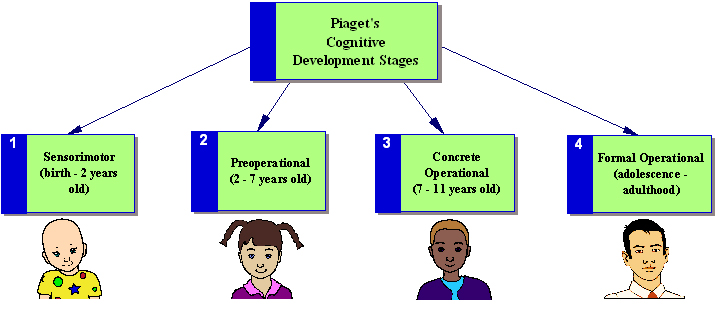A child is born into the world without any understanding of oral or written literacy. Much like literate cultures can trace their understandings back to an oral tradition, children are not naturally predisposed to the ability to read or write. In this respect a child’s understanding of oral literacy before the printed word represents the evolution of humankind’s literacy evolution.
Two of the preeminent cultural-historical psychologists, Lev Vygotsky and Jean Piaget, help to illuminate childhood understanding of oral signs in their examinations of cultural mediation and developmental stages. Vygotsky posits that development of a child through what Piaget identifies as the ‘the preoperational cognitive stage’ (age 2 – 7) is based largely on social interaction and the development of word meaning (Vygotsky, 1956). This is part of what Vygotsky termed as ‘cultural mediation’. Children actively construct their own knowledge through the meaning of verbal signs they interpret from significant people in their lives, particularly parents. It is not until the late preoperational stage (age 7 – 11) where intellectual development is demonstrated through the use of logical and systematic manipulation of symbols, which are related to concrete objects (Piaget, 1977).
What does this shift in understanding of visual symbols mean for thinking processes? Ong touches on this in his 1982 work “Orality and Literacy” when he states that “without writing, the literate mind would not and could not think as it does, not only when engaged in writing but normally even when it is composing its thoughts in oral form. More than any other single invention, writing has transformed human consciousness” (Ong, 1982) If cultures can ‘learn’ to write as children do, perhaps the effects on cognitive processes of both the individual and collective can be regarded as similar. Shaping understanding of the world primarily through oral or literary symbols has a profound effect on the very way in which we think; indeed this is the very argument Ong makes. Oral tradition transmits the history and understandings of a cultural through generations via speeches and songs which often time take on particular rhyme schemes and patterns to assist in their memorization. Similarly, children are often sung to, listening to songs such as nursery rhymes in their infancy and reciting them themselves in their youth. A prime example of the convergence of song, literary symbol and language is the alphabet song.
This understanding of both culture and the child can further be connected by introducing yet another psychologist, Jerome Bruner. He discusses how specific cultures have unique ways of learning, referring to them as ‘cultural amplifiers‘ (Bruner, 1966). Language – both oral and written are examples of such amplifiers which can be unique to specific cultures. Amplifiers are important because the highlight language not only in a communicative sense, but as a cultural artifact. Thus language possesses dual purposes; both for the child in cultural mediation and for society as a general tool.
Preliterate understanding for children, however, is not limited to oral language. Children in the aforementioned pre-operational stage are still very much visual learners, despite their inability to decipher text. Visual cues, such as pictures and gestures, as well as auditory cues all contribute to a child’s understanding of culture. This understanding of pictures as symbolic representations can be linked easily to preliterate cultures in the examples of cave paintings, right up to the cusp of the first literate cultures typified by the Egyptians and their hieroglyphics.
The evolution of culture from an oral to a literate one is generally supposed to be a positive one, much like the development of a child from one who only speaks and understands to one who can write. In James Gleick’s 2011 work “The Information”, he discusses this evolution from an oral to literate culture by connecting it to the emergence of Aristotelean and Platonic logic; an advancement in cultural cognition to be sure (Gleick, 2011). One might, however, argue that the movement from primarily oral communication, and the intimacy that involves, to the asynchronicity of written literacy actually represents a degeneration of communication. Ong highlights many of the unique positives of an oral culture. Among them include:
- In oral culture, the words are everything; they are performance, they are meaning, and they are central to all understanding and memory.
- Oral communication unites people in groups.
- Verbal performances are artistic and have human value
- Oral cultures tend to place more value on older members of society as storehouses of knowledge.
- Oral narratives have a deep connection with the lived experience and therefore resonate with the audience. (Ong, 1982)
So does the evolution from an oral to literate culture genuinely mirror that of a child’s development from an auditory/visual orientation to a literate one? It depends on whether one chooses to view it as a degeneration or evolution. A technological determinist would argue that writing, as a technology drives the development of a culture in the positive direction. A social determinist, on the other hand, would argue that social interactions, such as those between a child and parent, or an elder passing a story onto a subsequent generation, would likely be of more cultural value and certainly have more bearing on development.
Bruner, J.S. (1966). Toward a Theory of Instruction. New York: Norton.
Gleick, J. (2011). The Information: A History, a Theory, a Flood Fourth Estate; First Edition
Piaget, J. (1977). Gruber, H.E.; Voneche, J.J.. eds. The essential Piaget. New York: Basic Books.
Vygotsky, L. S. (1956/1987) The collected works of L. S. Vygotsky. Vol. 1 Problems of general psychology . New Y ork & London: Plenum Press.




Mark,
Thought provoking question in your last paragraph! I had to reread your post to find the answer. I concluded that as they grow, literacy is provided to children as another tool to help make sense of their world. I can see it becoming a valuable tool in the last stage of Piaget’s theory – the formal operational.
Jasmeet